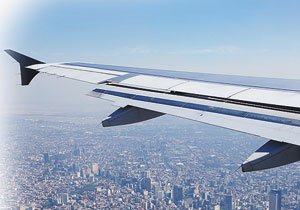”
To celebrate our new in-flight wine selection, tell us why
‘You’d Rather Be Drinking Wine than Working,’
”
tweeted Southwest Airlines. Fans of American Airlines’ New York
Facebook page got 10-percent-off coupons when the page reached
10,000 fans in May.
“To celebrate our new in-flight wine selection, tell us why ‘You’d Rather Be Drinking Wine than Working,'” tweeted Southwest Airlines.
Fans of American Airlines’ New York Facebook page got 10-percent-off coupons when the page reached 10,000 fans in May.
And a video of a Northwest Boeing 747 being repainted with the new Delta colors, posted in January, has been viewed more than 200,000 times on YouTube.
These are just some of the ways that airlines have started using social-media networks to boost their brands and interact with customers.
While consumers have long viewed the Internet as a way to vent frustration and complain about air travel, airlines are now actively engaging their customers via the Web. Some airlines, like JetBlue and Southwest, jumped wholeheartedly into the world of social media, launching blogs and Twitter accounts a couple of years ago, but most are cautiously tiptoeing into this new form of customer relations.
“We’re seeing a lot of testing by airlines,” said Forrester Research analyst Henry Harteveldt. No one, he said, wants to be in the same situation as United Airlines was this summer when a Canadian musician posted a music video on YouTube describing how the airline destroyed his guitar. “They are trying to figure out, given limited staff and limited budget, what’s going to get them the best return from social media.”
Fort Worth-based American Airlines has decided to take social media a little further, announcing this month that it will launch its own social network aimed specifically at African-American travelers, called BlackAtlas.com. The site will have featured bloggers and rely on user-generated content about travel destinations from an African-American viewpoint.
“Social media is the next great frontier,” said Roger Frizzell, American’s vice president of corporate communications. “Developing BlackAtlas.com is our first foray into something that may be new and unique.”
Airlines have been online for more than a decade, first with informational pages and then with Web sites where customers could buy tickets. As social-media networks began adding millions of members, low-cost carriers made the most of the emerging technology, analysts say.
Dallas-based Southwest has several employees that man the company’s Nuts About Southwest blog, Facebook page and Twitter account. And it’s not always promotions, contests and videos of commercials on these sites.
In July, when a Southwest airplane made an emergency landing because of a football-size hole in its cabin, the company tweeted the news that it had landed safely.
“It is the most efficient way to share news, whether it’s to our customers or to our employees,” said Southwest communications specialist Christi Day. Day, who is responsible for monitoring Twitter for the airline, said its Twitter page is growing by 7,000 followers a day, with close to 775,000 people following the airline’s tweets.
In comparison, JetBlue has more than 1.3 million followers, while legacy carrier American has a little over 16,000.
When Delta Air Lines was merging with Northwest Airlines, Atlanta-based Delta put together a minisite with videos that featured employees. But it was a video of a Northwest 747 being repainted in Delta colors that became a YouTube hit.
By tapping into the aviation geek community with that video, Delta has continued to cultivate that relationship, often posting on its corporate blog which planes it has updated with Wi-Fi service, Harteveldt said. The company has also used its celebrity spokesmen, like NFL quarterback Carson Palmer, to write blog postings.
But Delta has not used Facebook aside from creating a fan page for its charitable work, and its Twitter account only has about 13,000 followers. The company said that it is evaluating its social-media strategy and that instead of hiring a team of workers dedicated to social media, it plans to have current employees across several departments become involved with the airline’s online presence.
“Although we will have some resources dedicated to social media, we really see, for us, incorporating those channels within our existing business,” said Susan West, general manager in corporate communications.
Most companies are still using social media ineffectively, said George Low, chairman of the marketing department at Texas Christian University’s Neeley School of Business. For example, corporate blogs or CEO blogs often don’t attract new customers, instead just bringing in customers already loyal to the company.
“If all it is is a Web site that has information and connects somehow to customers using Facebook or one of the other big social sites, that is not really sufficient,” Low said.
Companies are starting to move beyond open social-network sites like Twitter and creating their own brand communities, said Dan Howard, professor of marketing at Southern Methodist University’s Cox School of Business.
For example, Procter & Gamble has created beinggirl.com, an online community targeted at teenage girls where they can talk about puberty and feminine issues, all while the company is subtly promoting its deodorants, shaving creams and hygiene products. Howard said P&G spends about $3 million a year but gets three times the return from its investment as girls switch to their products.
“People who interact in brand communities end up being more loyal, especially if they give feedback and you have a company rep saying ‘thank you for your comments,'” Howard said.
American Airlines’ BlackAtlas.com is a move in the right direction, Howard said, adding that it is the first brand community he is aware of in the airline industry.
American conducted focus groups with African-American customers to help shape the creation of BlackAtlas, said Sonja Whitemon, senior manager of advertising. Users will be able to search for fares and vacation packages, but Whitemon was adamant that BlackAtlas will not turn into a promotional site for American.
The airline is also looking at creating a site in 2010 that would link the many Twitter, Facebook and YouTube videos that American is involved in, Frizell said.
“There is a natural conversation that is already occurring,” Frizzell said. “The question is, are you part of the conversation or are you going to let it happen about you?”
Social media is the next great frontier. Developing BlackAtlas.com is our first foray into something that may be new and unique.”















